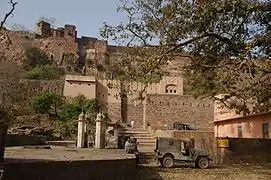Ranthambore Fort
Ranthambore Fort lies within the Ranthambore National Park, near the city of Sawai Madhopur, the park being the former hunting grounds of the Maharajahs of Jaipur until the time of India's Independence. It is a formidable fort having been a focal point of the historical developments of Rajasthan. The fort was held by the Chahamanas (Chauhans) until the 13th century, when the Delhi Sultanate captured it.
| Ranthambore Fort | |
|---|---|
 | |
| Type | fortress |
| Location | Sawai Madhopur, Rajasthan, India |
| Coordinates | 26°1′13″N 76°27′18″E |
| Area | 102 ha (0.39 sq mi) |
| Built | 10th Century CE |
| Type | Cultural |
| Criteria | Cultural: (ii)(iii) |
| Designated | 2013 (37th session) |
| Part of | Hill Forts of Rajasthan |
| Reference no. | 247 |
| ID | 247rev-003 |
| Region | Asia and the Pacific |
| Buffer Zone | 372 ha (1.44 sq mi) |
 Location of Ranthambore Fort in Rajasthan  Ranthambore Fort (India) | |
In 2013, at the 37th session of the World Heritage Committee, Ranthambore Fort, along with 5 other forts of Rajasthan, was declared a UNESCO World Heritage Site under the group Hill Forts of Rajasthan.[1]
History
A widely held belief states that the fort was built in the reign of Sapaldaksha, in 944 CE. Another theory states that the fort was built during the reign of Jayant, in 1110 CE. According to Government of Rajasthan's Amber Development & Management Authority, it is likely that the construction started in the mid-10th century during the reign of Sapaldaksha, and continued a few centuries after that.[2]
Under Chauhans
Its earlier name was Ranastambha or Ranastambhapura. It was associated with Jainism during the reign of Prithviraja I of Chahamana (Chauhan) dynasty in the 12th century. Siddhasenasuri, who lived in the 12th century has included this place in the list of holy Jain tirthas. In the Mughal period, a temple of Mallinatha was built in the fort.[3]
After the defeat of Prithviraja III (Prithviraj Chauhan) in 1192 CE, the fort came under the control of the Muslim Ghurid ruler Muhammad of Ghor. Prithviraja's son Govindaraja IV accepted the Ghurid suzerainty, and ruled Ranthambore as his vassal.[4] His descendants made various attempts to become independent.
The Delhi Sultan Iltutmish captured Ranthambore in 1226, but the Chauhans recaptured it after his death in 1236. The armies of Sultan Nasiruddin Mahmud, led by the future Sultan Balban, unsuccessfully besieged the fortress in 1248 and 1253, but captured from Jaitrasingh Chauhan in 1259. Shakti Dev succeeded Jaitrasingh in 1283, and recaptured Ranthambore and enlarged the kingdom. Sultan Jalal ud din Firuz Khalji briefly besieged the fort in 1290-91. In 1299, Hammiradeva sheltered Muhammad Shah, a rebel general of Sultan Ala ud din Khalji, and refused to turn him over to the Sultan. The Sultan besieged and conquered the fort in 1301.
Under Mewar
The fortress was captured by various kings of Mewar. Ranthambore was under the direct rule of Rana Hamir Singh (1326–1364), Rana Kumbha (1433–1468) and Rana Sanga (1508–1528).[5][6][7]
Under Hadas
During Rana Udai Singh I's reign (1468–1473) the fortress passed to the Hada Rajputs of Bundi. Sultan Bahadur Shah of Gujarat captured the fortress from 1532 to 1535. The Mughal Emperor Akbar the Great captured the fortress in Siege of Ranthambore (1568) from Hadas.
Under Jaipur
The fortress passed to the Kachwaha Maharajas of Jaipur in the 17th century, and it remained part of Jaipur state until Indian Independence. The area surrounding the fortress became a hunting ground for the Maharajas of Jaipur. Jaipur state acceded to India in 1949, becoming part of the state of Rajasthan in 1950.
Temples
Inside Ranthambore fort, there are three Hindu temples dedicated to Ganesha, Shiva and Ramlalaji constructed in 12th and 13th centuries from red Karauli stone. There is also a Jain temple of Lord Sumatinath (5th Jain Tirthankar) and Lord Sambhavanath.
Nearby attractions
- Water gateways
- Kachida Valley
- Surwal Lake
- Sitla Mata
- Picnic sports
- Malik Talao
- Wild life
- Bakula
- Lakarda And Anantpura
- Rajbagh Talao
- Ranthambore National Park
- Historical places
- Jogi Mahal
- Padam Talao
- Raj Bagh Ruins
- Ranthambhore Fort
- Ranthambhore School Of Art
- Ganesha temple
- Jain Temple
Gallery
 The way inside the fort
The way inside the fort History of Ranthambore Fort written on the wall
History of Ranthambore Fort written on the wall Jain temple at Ranthambore Fort
Jain temple at Ranthambore Fort.jpg.webp) Battees Khamba
Battees Khamba Annapurna Temple
Annapurna Temple Fine rock art at Ranthambhore Fort
Fine rock art at Ranthambhore Fort Old tomb, Ranthambore Fort
Old tomb, Ranthambore Fort Rani Haveli
Rani Haveli Ranthambore Fort Jain Temple
Ranthambore Fort Jain Temple Entrance
Entrance Naulakha Gate, Ranthambhore Fort
Naulakha Gate, Ranthambhore Fort
See also
References
| Wikimedia Commons has media related to Ranthambore Fort. |
- "UNESCO World Heritage". Retrieved 27 February 2018.
- "Hill Forts of Rajasthan: Ranthambore". Amber Development & Management Authority. Retrieved 6 March 2016.
- Singh, Narendra (1 January 2001). Encyclopaedia of Jainism. 1. Anmol Publications / Indo-European Jain Research Foundation. p. 5538. ISBN 978-81-261-0691-2.
- Dasharatha Sharma (1959). Early Chauhān Dynasties. S. Chand / Motilal Banarsidass. p. 102. ISBN 9780842606189.
- Historical Dictionary of Medieval India By Iqtidar Alam Khan pg 126
- IA, Vol. XLII, pp. 57-64
- Mishra, Shyam Manohar (1977). Yasovarman of Kanau,p.123. Retrieved 25 September 2012.
External links
| Wikiquote has quotations related to: Ranthambore Fort |
 Ranthambore Fort travel guide from Wikivoyage
Ranthambore Fort travel guide from Wikivoyage


